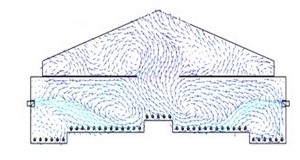By Amy Duke
Research carried out by faculty in Penn State's College of Agricultural Sciences is helping commercial poultry operations — some with multiple buildings each housing between 20,000 and 50,000 hens — convert from traditional caged housing to noncaged systems while safeguarding animal and employee safety.
The U.S. Department of Agriculture reports that a growing consumer demand for cage-free eggs and egg products has prompted many large institutional buyers to move toward doing business only with cage-free production facilities, according to Eileen Fabian, professor of agricultural engineering and environmental biophysics.
Fabian explained that producers and those who build poultry facilities need to understand the options for transitioning from birds kept in many rows and columns of cages in a hen house, to having loose birds in the same building.
“There is a lot to consider, most importantly air quality and comfort of the birds,” she said. “Poor ventilation can lead to an unhealthy indoor environment with unsuitable levels of humidity and contaminants.”
Hens in cage-free houses, she noted, initially suffered from higher particulate and ammonia levels than those in traditional cage houses since not all manure is removed daily and birds can scratch in the litter bedding.
Fabian and Long Chen, junior researcher at Tianjin Academy of Agricultural Sciences in China, who was then a Penn State doctoral candidate, began the study in 2017. Their goals were to design effective systems for improving indoor air quality and uniformity in cage-free poultry facilities and to develop mechanisms that reduce airborne disease spread within and between hen houses.
To do that, the pair teamed with Paul Patterson, professor of poultry science, Daniel Hofstetter, extension research assistant, and John Cimbala, professor of mechanical engineering in the College of Engineering, to conduct on-site assessments of several poultry production facilities in Pennsylvania and gather input from agricultural construction professionals.
Using a state-of-the-art computer design and analysis tool called computational fluid dynamics, or CFD, the team ran simulations of current ventilation system configurations in poultry houses to evaluate indoor air flow patterns and air-quality parameters such as temperature, humidity and potential disease particle spread during an outbreak.
Those data in hand, the researchers created a three-dimensional model of a commercial floor-raised, cage-free hen house, representing a typical stocking density. A one-eighth section of the barn was modeled at full scale with birds represented by hen-shaped, heated solid bodies.
The model also featured a typical design with top-wall inlets and side-wall exhaust ventilation configuration. As an alternative to improve ventilation effectiveness, the team evaluated three configurations that provided a more upward air flow from inlets lower in the sidewall and exhaust fans at the building ceiling or peak.

A cross section of a hen house with air flow direction and speed (lighter is faster) for one of the four computational fluid dynamics models.
This series of fresh-air inlets and exhaust fans positioned at different points in the house allowed comparisons of how fresh air is delivered to the hen-occupied area of the building and how contaminated air circulates before being removed. They repeated their simulations, measuring contours of airflow, temperature and pressure.
The results suggested that the team’s ventilation design provided a comfortable temperature and appropriate air circulation at the bird level, even during cold weather. It also improved air quality by reducing the spread of contaminants and particles in the air through the development of new, uniform design options, all of which promote animal welfare and address consumer values.
The findings, published in the journal Animal, were shared with egg producers, allied industries, regulators and consumers through several Penn State Extension seminars and on-farm demonstrations.
“Computational fluid dynamics modeling is a powerful tool to assess a ventilation system and its impact on the indoor environment for comfort, particularly within the animal-occupied zone of livestock housing,” Fabian said. “We will continue building on this work by creating additional designs.”
The U.S. Egg Industry Center provided funding for this project.
Source : psu.edu